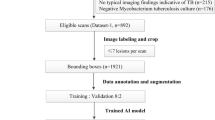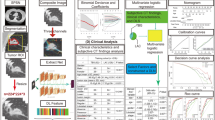Abstract
Objectives
To compare the [18F]FDG PET/CT findings of untreated sarcoidosis and malignant lymphoma (ML) and develop convolutional neural network (CNN) models to differentiate between these diseases using maximum intensity projection (MIP) [18F]FDG PET images.
Methods
We retrospectively collected data on consecutive patients newly diagnosed with sarcoidosis and ML who underwent [18F]FDG PET/CT before treatment. Two nuclear radiologists reviewed the images. CNN models were created using MIP PET images and evaluated with k-fold cross-validation. The points of interest were visualized using gradient-weighted class activation mapping (Grad-CAM).
Results
A total of 56 patients with sarcoidosis and 62 patients with ML were included. Patients with sarcoidosis had more prominent FDG accumulation in the mediastinal lymph nodes and lung lesions, while those with ML had more prominent accumulation in the cervical lymph nodes (all p < 0.001). For the mediastinal lymph nodes, sarcoidosis patients had significant FDG accumulation in the level 2, 4, 7, and 10 lymph nodes (all p < 0.01). Otherwise, the accumulation in ML patients tended to be in the level 1 lymph nodes (p = 0.08). The CNN model using frontal and lateral MIP images achieved an average accuracy of 0.890 (95% CI: 0.804–0.977), a sensitivity of 0.898 (95% CI: 0.782–1.000), a specificity of 0.907 (95% CI: 0.799–1.000), and an area under the curve of 0.963 (95% CI: 0.899–1.000). Grad-CAM showed that the model focused on the sites of abnormal FDG accumulation.
Conclusions
CNN models based on differences in FDG accumulation sites archive high performance in differentiating between sarcoidosis and ML.
Clinical relevance statement
We developed a CNN model using MIP images of [18F]FDG PET/CT to distinguish between sarcoidosis and malignant lymphoma. It achieved high performance and could be useful in diagnosing diseases with involvement across organs and lymph nodes.
Key Points
• There are differences in FDG distribution when comparing whole-body [18F]FDG PET/CT findings in patients with sarcoidosis and malignant lymphoma before treatment.
• Convolutional neural networks, a type of deep learning technique, trained with maximum-intensity projection PET images from two angles showed high performance.
• A deep learning model that utilizes differences in FDG distribution may be helpful in differentiating between diseases with lesions that are characteristically widespread among organs and lymph nodes.






Similar content being viewed by others
Abbreviations
- AUC:
-
Area under the curve
- CNN:
-
Convolutional neural network
- DLBCL:
-
Diffuse large B-cell lymphoma
- GLUT-1:
-
Glucose transporter 1 isoforms
- GLUT-3:
-
Glucose transporter 3 isoforms
- Grad-CAM:
-
Gradient-weighted class activation mapping
- MIP:
-
Maximum intensity projection
- ML:
-
Malignant lymphoma
- ROC:
-
Receiver operating characteristic
- SUVmax:
-
Maximum standard uptake value
References
Grunewald J, Grutters JC, Arkema EV, Saketkoo LA, Moller DR, Muller-Quernheim J (2019) Sarcoidosis. Nat Rev Dis Primers 5:45
Swerdlow SH, Campo E, Pileri SA et al (2016) The 2016 revision of the World Health Organization classification of lymphoid neoplasms. Blood 127:2375–2390
Tana M, di Carlo S, Romano M, Alessandri M, Schiavone C, Montagnani A (2019) FDG-PET/CT assessment of pulmonary sarcoidosis: a guide for internists. Curr Med Imaging Rev 15:21–25
Gümüştaş S, Inan N, Akansel G, Başyïğït I, Cïftçi E (2013) Differentiation of lymphoma versus sarcoidosis in the setting of mediastinal - hilar lymphadenopathy: assessment with diffusion-weighted MR imaging. Sarcoidosis Vasc Diffuse Lung Dis 30:52–59
Lale K, Harry AJ, Stantley JG (2003) Clinical role of FDG PET in evaluation of cancer patients. Radiographics 23:315–340
Charito L, Maria BT, Gene GT, Christopher JP (2005) FDG PET of infection and inflammation. Radiographics 25:1357–1368
Weclawek M, Ziora D, Jastrzebski D (2020) Imaging methods for pulmonary sarcoidosis. Adv Respir Med 88:18–26
Adams H, Keijsers RG, Korenromp IH, Grutters JC (2014) FDG PET for gauging of sarcoid disease activity. Semin Respir Crit Care Med 35:352–361
Khandani AH, Dunphy CH, Meteesatien P, Dufault DL, Ivanovic M, Shea TC (2009) Glut1 and Glut3 expression in lymphoma and their association with tumor intensity on 18F-fluorodeoxyglucose positron emission tomography. Nucl Med Comm 30:594–601
Shetty A, Carter JD (2011) Sarcoidosis mimicking lymphoma on FDG-PET imaging. Radiol Case Rep 6:409
Hosny A, Parmar C, Quackenbush J, Schwartz LH, Aerts H (2018) Artificial intelligence in radiology. Nat Rev Cancer 18:500–510
Currie G, Rohren E (2021) Intelligent imaging in nuclear medicine: the principles of artificial intelligence, machine learning and deep learning. Semin Nucl Med 51:102–111
Sibille L, Seifert R, Avramovic N et al (2020) (18)F-FDG PET/CT uptake classification in lymphoma and lung cancer by using deep convolutional neural networks. Radiology 294:445–452
Kawauchi K, Furuya S, Hirata K et al (2020) A convolutional neural network-based system to classify patients using FDG PET/CT examinations. BMC Cancer 20:227
Noriharu S, Yamaguchi T (2015) Diagnosis criteria and classification of disease severity for sarcoidosis in Japan. Jpn J Sarcoidosis Granuloma Dis 35:3–8
Tsuchiya J, Yokoyama K, Yamagiwa K et al (2021) Deep learning-based image quality improvement of (18)F-fluorodeoxyglucose positron emission tomography: a retrospective observational study. EJNMMI Phys 8:31
Rusch VW, Asamura H, Watanabe H, Giroux DJ, Rami-Porta R, Goldstraw P (2009) The IASLC lung cancer staging project: a proposal for a new international lymph node map in the forthcoming seventh edition of the TNM classification for lung cancer. J Thorac Oncol 4:568-577
Heo TY, Kim KM, Min HK et al (2020) Development of a deep-learning-based artificial intelligence tool for differential diagnosis between dry and neovascular age-related macular degeneration. Diagnostics (Basel) 10:216
Nalepa J, Marcinkiewicz M, Kawulok M (2019) Data augmentation for brain-tumor segmentation: a review. Front Comput Neurosci 13:83
Ramprasaath RS, Michael C, Abhishek D, Ramakrishna V, Devi P, Dhruv B (2019) Grad-CAM: visual explanations from deep networks via gradient-based localization. Available at: https://doi.org/10.48550/arXiv.1610.02391. Accessed September 01, 2022
Kanda Y (2013) Investigation of the freely available easy-to-use software ‘EZR’ for medical statistics. Bone Marrow Transplant 48:452–458
Diederik PK, Jimmy LB (2014) ADAM: a method for stochastic optimization. Available at: https://doi.org/10.48550/arXiv.1412.6980. Accessed September 01, 2022
Takahashi K, Fujioka T, Oyama J et al (2022) Deep learning using multiple degrees of maximum-intensity projection for PET/CT image classification in breast cancer. Tomography 8:131–141
Torres-Velazquez M, Chen WJ, Li X, McMillan AB (2021) Application and construction of deep learning networks in medical imaging. IEEE Trans Radiat Plasma Med Sci 5:137–159
Zhang Y, Du SS, Zhao MM et al (2022) Chest high-resolution computed tomography can make higher accurate stages for thoracic sarcoidosis than X-ray. BMC Pulm Med 22:146
Capobianco N, Meignan M, Cottereau AS et al (2021) Deep-learning (18)F-FDG uptake classification enables total metabolic tumor volume estimation in diffuse large B-cell lymphoma. J Nucl Med 62:30–36
Blanc-Durand P, Jegou S, Kanoun S et al (2020) Fully automatic segmentation of diffuse large B cell lymphoma lesions on 3D FDG-PET/CT for total metabolic tumour volume prediction using a convolutional neural network. Eur J Nucl Med Mol Imaging 48:1362–1370
Wang X (2015) PET/CT: appropriate application in lymphoma. Chin Clin Oncol 4:4
Khan AB, Barrington SF, Mikhaeel NG et al (2013) PET-CT staging of DLBCL accurately identifies and provides new insight into the clinical significance of bone marrow involvement. Blood 122:61–67
Mehrian P, Ebrahimzadeh SA (2013) Differentiation between sarcoidosis and Hodgkin’s lymphoma based on mediastinal lymph node involvement pattern: evaluation using spiral CT scan. Pol J Radiol 78:15–20
Santos FS, Verma N, Marchiori E et al (2021) MRI-based differentiation between lymphoma and sarcoidosis in mediastinal lymph nodes. J Bras Pneumol 47:e20200055
Lovinfosse P, Ferreira M, Withofs N et al (2022) Distinction of lymphoma from sarcoidosis at FDG PET/CT - evaluation of radiomic-feature guided machine learning versus human reader performance. J Nucl Med. https://doi.org/10.2967/jnumed.121.263598
Funding
This study was supported by a grant to the Diffuse Lung Diseases Research Group from the Ministry of Health, Labor and Welfare, Japan (grant number 20FC1033).
Author information
Authors and Affiliations
Corresponding author
Ethics declarations
Guarantor
The scientific guarantor of this publication is Yasunari Miyazaki.
Conflict of Interest
The authors declare no competing interests.
Statistics and Biometry
One of the authors has significant statistical expertise.
Informed Consent
Written informed consent was waived by the Institutional Review Board.
Ethical Approval
Institutional Review Board approval was obtained.
Study subjects or cohorts overlap
Not applicable.
Methodology
• retrospective
• diagnostic or prognostic study
• multicenter study
Additional information
Publisher's note
Springer Nature remains neutral with regard to jurisdictional claims in published maps and institutional affiliations.
Supplementary Information
Below is the link to the electronic supplementary material.
Rights and permissions
Springer Nature or its licensor (e.g. a society or other partner) holds exclusive rights to this article under a publishing agreement with the author(s) or other rightsholder(s); author self-archiving of the accepted manuscript version of this article is solely governed by the terms of such publishing agreement and applicable law.
About this article
Cite this article
Aoki, H., Miyazaki, Y., Anzai, T. et al. Deep convolutional neural network for differentiating between sarcoidosis and lymphoma based on [18F]FDG maximum-intensity projection images. Eur Radiol 34, 374–383 (2024). https://doi.org/10.1007/s00330-023-09937-x
Received:
Revised:
Accepted:
Published:
Issue Date:
DOI: https://doi.org/10.1007/s00330-023-09937-x




